Have you ever thought about that song? I mean really thought about it?
Here’s what you’d have at the end of 12 days if you had a relationship with this guy (or gal)!
12 Pear trees (that’s a small orchard!)
12 Partridges (these are short-tailed game birds similar to a quail, but larger. Remember the Partridge Family? Haha!!)
22 Turtle doves (these are similar to the mourning doves we see in America, but are native to Europe)
30 French hens (these are just chickens – female chickens)
36 Calling birds (originally, these weren’t ‘calling birds’, but ‘collie’ birds – an archaic term for blackbirds. Well, you could put 4 and 20 in a pie I suppose . . . but then you’d have to find a King to give it to . . .)
40 Golden rings (hey, if they’re pure gold, they’re worth a lot of money! And cost a small fortune, too!
42 Laying geese (1 goose can lay between 10-25 eggs per year, so by next year . . . YIKES! Unless you use the eggs to feed your new tenants?)
42 Swimming swans (swans need a pond and one pair require about 90 x 100 yards. I couldn’t find out how much room you need for this many. Maybe a large lake!)
40 Milkmaids (if they’re staying, they need room and board. Regardless, they’ll need cows to milk. You didn’t get cows, so you’ll have to buy some. I’m guessing for this many maids, you’ll need a herd. They cost $900-3,000 EACH depending on where you live. I guess you could sell some of the rings . . .)
36 Dancing ladies (more room and board and you’ll have to add on a large studio, complete with sound equipment for music. Unless you just “pipe” it in. 😊 see ‘Pipers’ below.)
30 Leaping lords (There’s no stipulation on where they’re jumping around, so I’m guessing you don’t need more space. They can be outside or share the studio with the ladies. However, you will be required to provide more room and board and generally, men eat a lot more, especially if they’ve been exercising. On the other hand, those birds could come in handy . . . )
22 Pipers (these are like flute players, not plumbers)
12 Drummers (Now there’s something I could really enjoy! I love a good drum line! But again, room and board. I’m assuming since they were drumming when you got them, they came with their drums. Whew!! Still, they gotta eat and sleep.)
So, to break it down a bit, you’ll have a small orchard, 184 fowl, 40 rings, and 110 adults.
You’ll need LOTS of land, a hotel-size house (or just a hotel), some cows and a barn to keep them in, enough food for all those birds and bovine, and don’t forget feeding the equivalent of a small cruise ship of people, and a safe to protect all those rings. Oh! And what if those people have families??? That’s more housing and food!
Looking at all this, your true love better also provide a huge estate!
I think I’d cut him off after the turtle doves. I don’t much care for keeping birds. They’re noisy and worst of all, they’re dirty and smelly.
In my pursuit of facts, I discovered the verse was originally published in England in 1780 and set to the tune we recognize in 1909. And actually, the 12 days are from December 25th to January 5th.
Now. Enough goofing around.
I started my day battling the demon ‘vanity’. Battles are always ugly by nature. This one was no different. Poor Blaine. Eventually, I got over it, apologized and we began our day over again.
We drove into Charleston, SC – originally named Charles Town – in just under an hour. It was supposed to be a 45 minute drive, but traffic was terrific. The town was founded in 1670 and named in honor of King Charles II of England.

Our first glimpse of Charleston. Nice . . .
It wasn’t a particularly nice day – overcast and about 72 today, but that’s OK. It was a good day for walking around the city!
Once parked, we made our first stop the Visitor Center. They gave us some information, including a map of the city so we could walk around. The guy marked a few places of interest.
Then we headed out to explore Historic Charleston. We took way too many pictures of old houses and buildings, but that’s OK. Some people probably believe it’s healthier than all those tombstones we took the other day. 😊
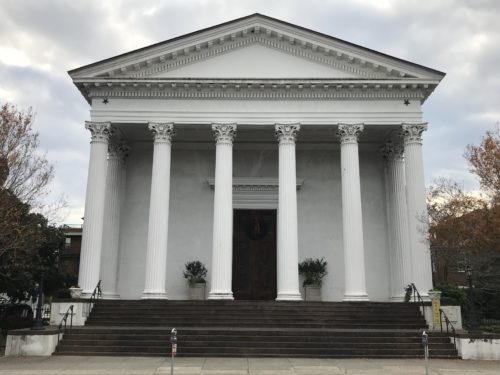
This is a Methodist Church.
The next three pictures are of this building.
Hey – we were just getting started! Everything was exciting and needed to be documented!
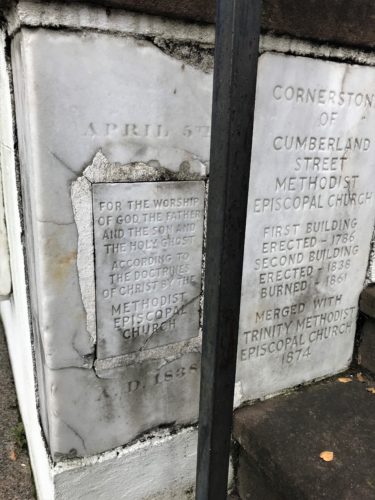

Just look at the ornate work! Beautiful!

Everything was exciting and needed to be documented!

This is a Baptist Church taken from the town square

We took this one later in the day when we got over there.
It was so huge though, this was the best we could do.
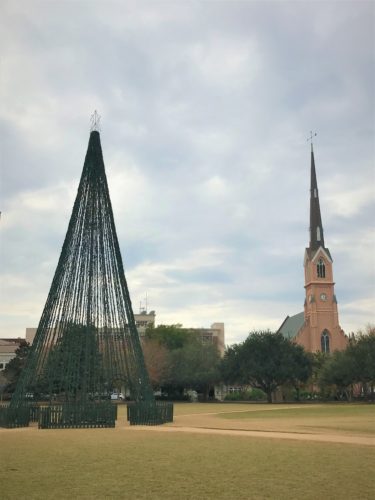
The town tree.
They lit it the next day after the parade.
I don’t know what church that is.
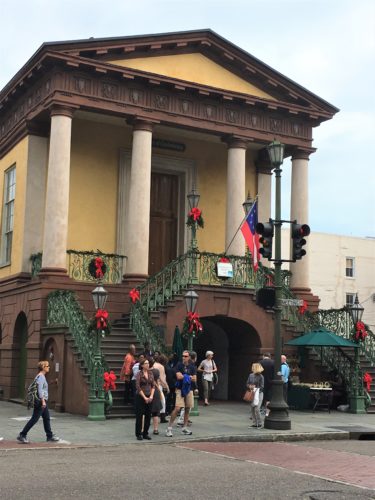
The DAR building.
“Daughters of the American Revolution”

Oh, look dear! Another cemetery!
We didn’t go into this one. : )

This plaque and the next were taken to put with the pictures of the buildings.
We couldn’t take the fronts from the same side of the street, so the intention was to take them on the way back.
We didn’t go back the same way.
No pictures of the buildings. Sorry!


This one MIGHT be the Hibernian Society building – since the sign by the door says “Private”

Looking down Meeting Street


Doesn’t this view make the columns look crooked?
Weird!
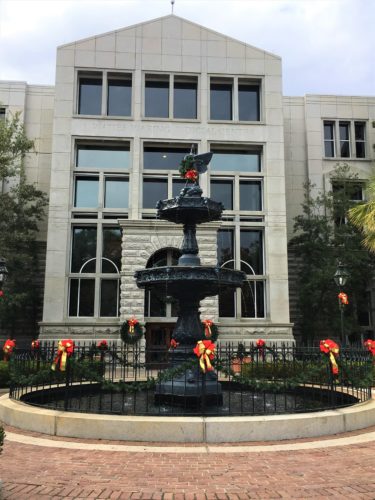

Someone’s yard


And another one!



An orange tree!

Someone’s front yard

We took this picture for the carriage. We were waiting for it to pass in front of the house, but they stopped and talked for too long, so we moved on.

Not much room between these houses!
The street ended at Battery Park, so our tour took us around the Park and by the the water’s edge.


There’s some pretty major updating/remodeling going on here

I liked the look of this house.

Battery Park
They actually have certain hours when your dog is allowed to be off-leash!


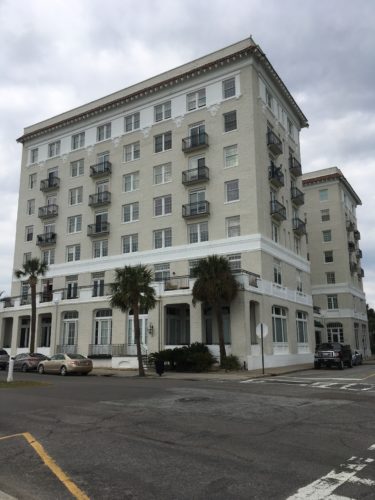
There are a few more modern buildings around here, too.



We could see Fort Sumter from here, but it was a really long way away. Does anyone know what this fort is famous for?

This plaque was at the viewing spot. I know you can’t really read it. Bummer!
No picture over the water – I thought Blaine took it, he thought I did. . . We’re considering taking the ferry and visiting it, so maybe later.



This place was enormous!

And look! It’s for sale!
Wanna buy? It’s only $5M . . .




Along the way, we ran into The Old Exchange and Provost Dungeon Museum.


This picture shows the building at one time (not sure when) when it was used for the Coast Guard.
I had read briefly about it, so we stopped in to check it out. Pretty interesting information here from both the Revolutionary and Civil Wars, and pirates. (Any Captain Jack Sparrow fans out there? 😊) The town was originally built as a fort and part of the original ‘ocean-side’ wall is actually underneath this building. The town borders were expanded to make room for more people – even on the water side. Also, two creeks that originally ran along either side of the fort were filled in.
This building was an Exchange Building for selling and trading goods and also next to the port to facilitate shipping and receiving goods. The town was very affluent at the time and the size and position of the building reflected that.





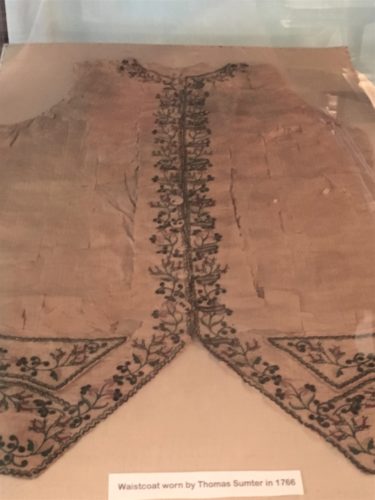
Here’s a few excerpts from their website:
How did the vulnerable Charles Town, the only fortified city in English America, become Charlestown, fourth largest, most beautiful, and wealthiest city in colonial America? The answer lies in the shipping trade. Rice, indigo, and slavery (“black ivory”) were the major ingredients in the original Low Country recipe, and it was on that simple but powerful economy that colonial Charlestown was built.
And it was the growth in trade that led directly to the construction of the Royal Exchange and Custom House.
(As a side note, I never knew indigo was a plant. I just thought it was a color in ROYGBIV. I suppose it’s that, but I never thought about how that color was made. Anyway, Indigo didn’t grow in England, so it was big business to export it from here. See later in the post for more info on indigo.)
Petitions and arguments before the Assembly by Charles Town’s wealthy merchants and investors prompted the government to pass an act in 1767 for the building of an “Exchange or Custom House.” Designed by [William Rigby] Naylor, the L 40,935 contract for the construction of the “Exchange” was awarded to Peter and John Adam Horlbeck, master masons and recent immigrants from Germany. This contract led to many others for the Horlbeck brothers, who invested in real estate, married well, and died leaving sizable estates.
The new Exchange was needed to accommodate the heavy export-import trade and as a place to conduct both public and private business. But the site, design, and construction of the building also symbolized the self:-image of Charles Town’s elite.
Before the Exchange era, they dealt with pirates for a number of years, the most notorious being Stede Bonnet. I don’t have any pictures of him. Sorry!
From the Smithsonian website, we find out about Mr. Bonnet:
Stede Bonnet’s career as the “Gentleman Pirate” may represent the worst midlife crisis on record. In 1717, Bonnet, a retired British army major with a large sugar plantation in Barbados, abandoned his wife, children, land and fortune; bought a ship; and turned to piracy on the high seas. Though his crew and fellow pirates judged him to be an inept captain, Bonnet’s adventures earned him the nickname “the Gentleman Pirate,” and today his legend lingers in the annals of pirate history.
Stede Bonnet had no knowledge of seafaring, having sailed only as a passenger. Moreover, he had no apparent reason to rage against the establishment. Bonnet was born in the 1680s in Barbados and, according to the transcript of his 1718 trial, had “the advantage of liberal education.” After retiring from the army with a rank of major, Bonnet bought an estate and settled in as a member of respectable society, where he spent a decade raising a family until he suffered some kind of mental break. A contemporary account of Bonnet’s career suggested that “some Discomforts he found in the married state” led to “this Humour of going a-pyrating,” but it seems unlikely that a nagging wife alone could be enough to drive a law-abiding gentleman to piracy.
Regardless of his motivation, Bonnet was determined to carry out his plan. Generally, anyone embarking on a career of piracy would begin by seizing a ship. Bonnet purchased his sloop legally. He armed it with ten cannons, hired a crew of 70 and named the ship Revenge. As Bonnet had no obvious enemy against which to revenge himself, it’s likely he chose a name that sounded menacing and pirate-esque—indeed, many pirate ships used the name Revenge.
After these early successes, Bonnet and his crew sailed south to Honduras, a well-known pirate hangout, to spend their booty. There, Bonnet met the most famous and feared pirate of his day: Blackbeard. Born in Bristol, England, Blackbeard had worked his way up from deckhand to captain of his own ship—the 40-gun Queen Anne’s Revenge—and cultivated a reputation for wildness and unpredictability. Bonnet was thrilled to make Blackbeard’s acquaintance, and the two pirate captains agreed to cruise together.
After they set sail, Blackbeard realized he was dealing with an amateur and decided to seize Bonnet’s command. He kept Bonnet aboard Queen Anne’s Revenge and sent his first mate to take over Bonnet’s ship, with the consent of Bonnet’s crew. The stout, upper-class Bonnet, Blackbeard explained, was not suited to be a pirate captain, and would do better to relax aboard the larger ship than suffer the trouble of commanding his own. Though nominally Blackbeard’s guest, Bonnet was essentially his prisoner, and with bruised feelings Bonnet plotted revenge.
When Blackbeard docked his fleet in North Carolina, Bonnet went ashore and returned to find that Blackbeard had stripped and abandoned the Revenge and marooned some 25 crewmembers on a small island. Bonnet took his ship back, picked up the men, and resumed his piratical pursuits, this time with the goal of punishing Blackbeard. Unfortunately, Blackbeard had a head start, so Bonnet had to content himself with seizing merchant vessels. His skills had improved since he had first embarked, and by abusing his crew, killing prisoners and threatening civilians, Bonnet eventually gained a fearsome reputation of his own.
As word spread about the Gentleman Pirate, the governor of South Carolina commissioned Colonel William Rhett to capture him. In August of 1718, Rhett cornered Bonnet at the mouth of the Cape Fear River, and after a violent firefight he managed to arrest the pirates. Though the hotheaded Bonnet declared he would blow up himself and the ship before he would surrender, his men overruled him and gave themselves up as prisoners. In custody, Bonnet tried to take advantage of his upper-class background in appealing to the governor for mercy and blaming everything on Blackbeard. His trial dragged out long after his men had been hanged, and the trial transcript is “one of the most valuable historical records we have about Bonnet and Blackbeard,” says David Moore. Finally convicted of piracy, Stede Bonnet was hanged on December 10, 1718, after less than two years of adventure on the high seas.
Bonnet’s execution came a month after Blackbeard had met his own bloody end in battle with the British Royal Navy.
During the Revolutionary War, The Exchange building was used to house prisoners, about 50-60 at any given time – both men and women and not just war criminals. There were all types of criminals here – thieves, prostitutes, perceived enemies of the Crown, you name it.

They’ve excavated part of the original wall so we can see it.

This is actually on the opposite side.
You can see how they added on beyond the wall.
Steps to . . .???
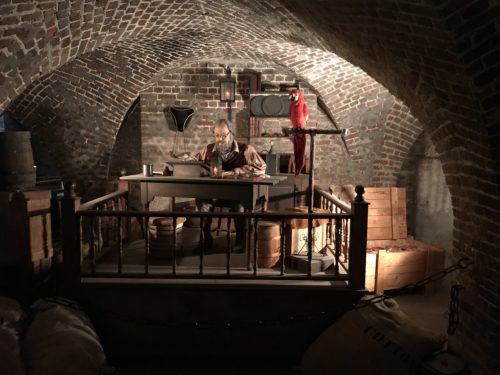
The prison steward’s office.
How’d ya like that job??
Dark, stinky, disease ridden . . .

Our guide told us a story about the Revolutionary War connected with this building. There was a powder magazine and when Charleston was about to surrender, they didn’t want the British to get their hands on the gunpowder. Some VERY loyal men, brought it to this building during the night and hid it all, then walled up the room where it was stored. No one ever said a word, and many years later, the wall was taken down and the powder brought out. Hard to believe everyone kept their mouth shut for so long!
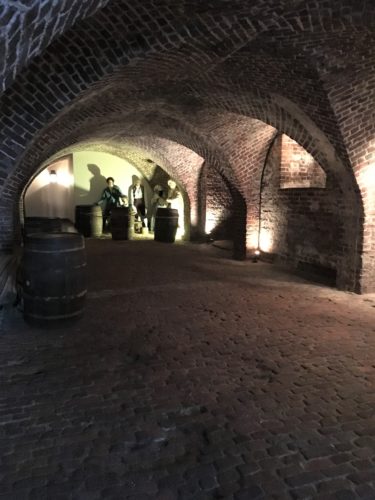
Issac Hayne was one of the infamous locals executed during the Revolutionary War. He was held prisoner in this dungeon, along with everyone else.
Here’s what the Exchange Website says about him:
Condemned to death by British authorities during the occupation of Charlestown in 1781, Isaac Hayne became perhaps the most prominent American to be executed during the American Revolution for treason against the Crown.
(Remember the war was from 1775-1783.)
At the time of the Revolution, Hayne was enjoying a profitable plantation life. Hayne Hall, located four miles from Jacksonborough, was an “elegant mansion house–brick barn, and stables, and every suitable building of a well settled rice plantation.” This plantation was Hayne’s residence and contained nine hundred acres. Hayne’s other two plantations called Pear Hill and Sycamore which had seven hundred and six hundred fifty acres, respectively. He owned five lots in Beaufort and two lots in Charlestown, plus an additional 6,377 acres, most of which was in the Up Country. He also owned one thousand acres in Georgia and some land in the New Acquisition. In York District he was partner with William Hill in the Aera Ironworks that manufactured ammunition for the use of the American forces.
Hayne was held in the prison of the provost, the basement of the Exchange.
Hayne sent for his attorney, John Colcock, who denied Rawdon’s or Balfour’s authority to pass such a sentence. Colcock asked that the ruling be overturned because Hayne had no knowledge of the intent of the board, because no one could be sentenced without a trial except a spy, and because Hayne’s guilt had not been proven. The only reaction to this from the officers in charge was the statement that his sentence was not due to a board of inquiry ruling but by virtue of the authority with which the commander-in-chief in South Carolina and the commanding officer in Charlestown were invested. The decision then rested clearly with Balfour and Rawdon, and their desire was to make an example of Hayne.
Hayne then asked for a respite that he might send for his children for a last farewell. This request was denied, and at one o’clock on the morning of July 31 Hayne was told that it was time to prepare for death. Hayne was informed that he would leave for his execution at five o’clock. Major Fraser returned shortly, however, with a message: “Colonel Hayne, I am to acquaint you, that in consequence of a petition signed by Governor Bull and many more, as also of your prayer of yesterday, and the humane treatment shewn by you to the British prisoners who fell into your hands, you are respited for forty-eight hours.” . . . The delays were probably granted while Balfour and Rawdon considered the entreaties for Hayne’s life made by the people of Charlestown. . . .
When Hayne’s son William Edward visited his father the night before his death and saw “upon one side of the room of his confinement a Hessian Soldier or Centinal on the [other] side a Coffin covered with Black Broad Cloth & lined with white.” Hayne’s eldest son Isaac accompanied his father to the “place of execution & after it took charge of his body and had it [conveyed] to the place of his Residence.”
. . . When these requests and the pleas of Hayne’s own children for their father’s life failed, Hayne was doomed.
An eyewitness account of the execution was delivered to Congress by Isaac Neufville, a fourteen-year-old boy from Charlestown. He said that Hayne “was escorted by a party of soldiers to a gallows erected without the lines of the town with his hands tied behind, and there hung up till he was dead.”
A contemporary of Hayne described the day: “The streets were crowded with thousands of anxious spectators . . . When the city barrier was past, and the instrument of catastrophe appeared full in view, a faithful friend by his side observed to him, ‘that he hoped he would exhibit an example of the manner in which an American can die.’ He answered with the utmost tranquility, ‘I will endeavor to do so.’ He ascended the cart with a firm step and serene aspect. He enquired of the executioner, who was making an attempt to get the cap over his eyes, what he wanted? Upon being informed of his design, the colonel replied, ‘I will save you that trouble, ‘ and he pulled it over himself. He was afterwards asked whether he wished to say anything, to which he answered, ‘I will only take leave of my friends, and be ready.’ He then affectionately shook hands with three gentlemen–recommended his children to their care–and gave the signal for the cart to move.”
They also used this basement dungeon to hold prisoners during the Civil War. In addition to this area, they also moored six ships off-shore and kept about 200 on each ship. Over 800 died imprisoned on those ships due to the filth, disease and their only rations being stale bread and water.
Out of the dungeon and up the stairs to the second floor of the building. Along the steps, there were all these really interesting pictures and information. Had it been a busy time, it would have been difficult to take the time to look.








George Washington and others met in this room!





I thought this was interesting, and much better than his idea for a turkey for our national bird!



We don’t really know what this is supposed to be.
We think it’s just depicting some Civil War period pieces?
And now, the indigo information I promised you. Are you still with me?? This posting has a LOT of history! : )


In 1742 the face of agriculture in South Carolina changed dramatically when Eliza Lucas, the 16-year-old daughter of a wealthy planter, successfully cultivated indigo for the first time in the American colonies. Because the rich, blue dye extracted from the indigo plant was rare—and expensive—it was a symbol of status and wealth and in high demand in Europe. In 1747 the first shipment of indigo left for England, and within two decades more than a million pounds would be shipped each year, making the dye one of the colony’s largest exports, second only to rice. Indigo production was an extremely labor-intensive, multi-day process that could only be profitable when done on a large scale with slave labor, which limited it to plantations. Though most South Carolinians had few slaves, some landowners had many. The production of indigo caused a spike in the importation of African slaves—who would go on to outnumber whites in the colony by two to one—while lining the pockets of the colony’s elite.
Extracting dye was a challenging and tedious process involving pounding indigo plants for up to 20 hours.
The increased demand for indigo required more labor, in turn creating higher demand for slaves. Up to 60 percent of all African slaves entering the American colonies during the 1700s landed in South Carolina.
Much of the dye imported from the American colonies was used to color luxury clothing for the Old World’s elite.
In May of 1791, two years into his presidency, President George Washington visited Charleston. It was apparently a really big deal. He was there for a week and addressed the citizens from The Old Exchange Building when he arrived in town. There were four lavish events held during his stay, including a ball and a concert.

All this and more from an hour spent in an old building!

This was on a table as we exited.
It was time to head back to the Jeep. We had a dinner and concert scheduled for this evening!

We think this is the Cathedral of St. John.

Gotta find out what kind of tree this is. They were all over the place. Very smooth bark. It looked painted.


We saw this at the beginning of our walk. (It’s by the Visitor Center) We didn’t feel right snapping a picture of the inside since people were in there, but it was actually full of cats! Cats, cat beds, cat scratchers, cat toys . . .
I like cats, but this is just weird! With a Capital W!
Dinner was at Nigel’s Good Food. The place is known for it’s great soul food. And it truly was great – well, part of it anyway. But it was all sogood! And very inexpensive! And although we ate heartily, we had enough left to take home for another meal.

Wings with their infamous “Geechi” sauce.
I don’t know what that is, but it was AMAZING!
Crispy wings and the sauce was a mix of hot and a little sweet. YUMMY!
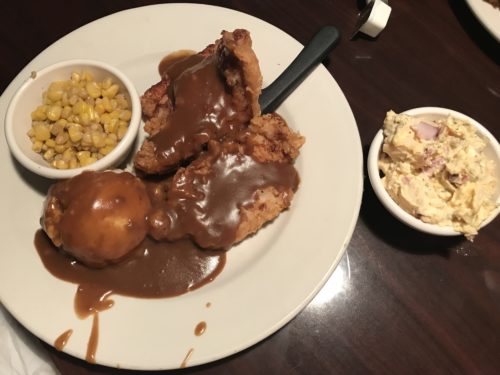
Blaine’s dinner.
Fried Pork Chops and gravy (same as mine, but with gravy poured over top)
Mashed potatoes
Corn
Potato Salad
Can you say ‘starch’?
When I gave the waitress my order of fried pork chops, she kindly informed me (knowing we hadn’t been there before) that there would be three. “Only three!” My sarcastic wit took over. I couldn’t help it. Oh, my goodness! So much yummy food!

My dinner.
Fried Pork Chops (no gravy)
Collard Greens
Fried Cabbage
Cornbread
Can you say ‘fat’?
We sampled everything we bought and determined that the best thing on the table (after the wings were cleared away) was the cabbage. It was obviously cooked in bacon grease and had pieces of kielbasa in it too. Oh, my was it good! Understandable, right?
I’d never had collards before. A little like spinach, but thicker. The server said they can be bitter tasting, ‘but not the way we make them’. They were loaded with bacon grease too. And the cornbread was better than any I’d ever had. A huge, thick, moist cake. Delicious!
Blaine’s potato salad was really good too! I think I could become a soul food addict. And probably gain about 100 pounds relatively quickly if I was!
A short drive and we were at the concert hall, anxious to see The Gaither’s Christmas Homecoming!!
Participating in this show were:
GVB (Gaither Vocal Band)
Mark Lowry
The Martins
Buddy Green
Lynda Randle
Charlotte Ritchie
Gene McDonald
Kevin Williams
Tickets were only $35 (including all the fees) and the concert was 3 ½ hours with only a 20 minute intermission!
It was wonderful! I can’t even think of enough fantastic expletive words! We sat next to a couple who ‘just happened’ to be familiar with the Givans Ferry area. He sometimes pastors at the Givans Ferry Baptist Church where we were planning on attending this coming Sunday. And his wife’s name is Terri. 😊
Pictures aren’t good, but I had to put something in. : )


This is a choir they brought in to add to the concert.
The Wilmington Celebration Choir

That’s Bill Gaither in the blue sleeved shirt.
Did you know he’s 81 now?!?
Gloria wasn’t there, but they played a few excerpts on the screens with her in them.




They gave everyone lighted key chains in two different colors.
Periodically, they had us wave them to look like stars.
The fabulous, worship-filled concert ended with “O Holy Night”. WOW!!!!
And then, on the way home, we enjoyed Pentatonix Christmas music. I’m always amazed at their acappella sound! It amazes me that only 5 people can make so much music and such a variety of sounds!
We didn’t get to bed until almost midnight! Good thing we can sleep in!
